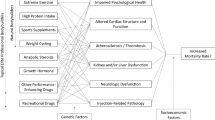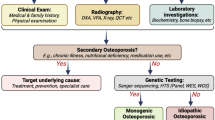Summary
Bone mineral content (BMC), bone mineral density, and metacarpal dimensions were studied in 50 women with Turner's syndrome aged 21–45 years in relation to karyotype, estrogen treatment, physical fitness, and biochemical markers of bone turnover. No differences were found between the 25 women with karyotype 45,X and women with other karyotypes. Forty-six women had received estrogen. Significant partial correlations were found between bone mineral density of the forearm and duration of estrogen treatment and physical fitness. BMC of the lumbar spine corrected for vertebral height (BMC(C)spine) was directly correlated with duration of estrogen treatment and height, marginally correlated with physical fitness, and inversely correlated with age. Outer metacarpal width was positively correlated with duration of estrogen treatment, age at initiation of therapy, and body weight. The diameter of medullary space showed negative correlation with physical fitness and height, and positive correlation with age at initiation of estrogen treatment. Cortical thickness was positively correlated with duration of estrogen treatment, physical fitness, and height. No convincing effects of estrogen could be demonstrated in women below the age of 30. Above the age of 30, all bone mineral measurements were markedly elevated in women treated for longer than the average of this age group. BMC(C)spine was inversely correlated with biochemical markers of bone formation. Our results demonstrate that estrogen treatment and physical fitness are important determinants of bone mineral status in Turner's syndrome and add to the evidence that estrogen treatment increases BMC in Turner's syndrome.
Similar content being viewed by others
References
Finby N, Archibald RM (1963) Skeletal abnormalities associated with gonadal dysgenesis. Am J Roentgenol 89:1222–1235
Engel E, Forbes AP (1965) Cytogenetic and clinical findings in 48 patients with congenitally defective or absent ovaries. Medicine 44:135–163
Preger L, Howard MB, Steinbach MD, Moskowitz P, Scully AL, Goldberg MB (1968) Roentgenographic abnormalities in phenotypic females with gonadal dysgenesis. Am J Roentgenol 104:899–910
Beals RK (1973) Orthopedic aspects of the XO (Turner's) syndrome. Clin Orthop Rel Res 97:19–29
Brown DM, Jowsey J, Bradford DS (1974) Osteoporosis in ovarian dysgenesis. J Pediatr 84:816–820
Stepan JJ, Musilova J, Pacovsky V (1989) Bone demineralization, biochemical indices of bone remodeling, and estrogen replacement therapy in adults with Turner's syndrome. J Bone Miner Res 4:193–198
Lemli L, Smith DW (1963) The XO syndrome: a study of the differentiated phenotype in 25 patients. J Pediatr 63:577–587
Smith MA, Wilson J, Price WH (1982) Bone demineralisation in patients with Turner's syndrome. J Med Genet 19:100–103
Ford CE, Jones KW, Polani PE, de Almeida JC, Briggs JH (1959) A sex-chromosome anomaly in a case of gonadal dysgenesis (Turner's syndrome). Lancet i:711–713
De Paepe A, Matton M (1985) Turner's syndrome: updating on diagnosis and therapy. Prog Clin Biol Res 200:283–300
Kim MH, Hosseinian AH, Sacris MO, Dupon C, Cleary RE (1974) Hormonal profile in patients with gonadal dysgenesis. Am J Obstet Gynecol 118:955–960
Conte FA, Grumbach MM, Kaplan SL (1975) A diphasic pattern of gonadotropin secretion in patients with the syndrome of gonadal dysgenesis. J Clin Endocrinol Metab 40:670–674
Lindsay R (1988) Sex steroids in the pathogenesis and prevention of osteoporosis. In: Riggs BL, Melton L (eds) Osteoporosis: etiology, diagnosis, and management. Raven Press, New York, pp 333–358
Brook CGD (1986) Turner syndrome. Arch Dis Child 61:305–309
Nielsen J, Nyborg H, Dahl G (1977) Turner's syndrome. A psychiatric-psychologic study of 45 women with Turner's syndrome compared with their sisters and women with normal karyotype, growth retardation and primary amenorrhoea. Acta Jutlandica XLV, Medicine series 21, University of Århus, Denmark
Nielsen J, Sillesen I (1981) Turner's syndrome in 115 Danish girls born between 1955 and 1966. Acta Jutlandica LIV, Medicine series 22, University of Århus, Denmark
Mascak CA, Lobo RA, Dozono-Takano R, Eggena P, Nakamura RM, Brenner PF, Mishell DR (1982) Comparison of pharmacodynamic properties of various estrogen formulations. Am J Obstet Gynecol 144:511–518
Nielsen HE, Mosekilde L, Mosekilde L, Melsen B, Christensen P, Olsen KJ, Melsen F (1980) Relations of bone mineral content, ash weight, and bone mass: implications for correction of bone mineral content for bone size. Clin Orthop Rel Res 153:241–247
Dequecker J (1972) Bone loss in, normal and pathological conditions (thesis). University Press, Leuven, The Netherlands
Price PA, Nishimoto SK (1980) Radiormmunoassay for the vitamin K-dependent protein of bone and its discovery in plasma. Proc Natl Acad Sci USA 77:2234–2238
Price PA, Otsuka AS, Poser JW, Kristaponis J, Raman N (1976) Characterization of a gamma-carboxyglutamic acid-containing protein from bone. Proc Natl Acad Sci USA 73:1447–1451
Keiding R, Hörder M, Gerhardt W, Pitkänen E, Tenhunen R, Strömme JH, Theodorsen L, Waldenström J, Tryding N, Westlund L (1974) Recommended method for the determination of four enzymes in blood. Scand J Clin Lab Invest 33:291–306
Rosalki SB, Foo AY (1984) Two new methods for separating and quantifying bone and liver alkaline phosphatase isoenzymes in plasma. Clin Chem 30/7:1182–1186
Behr W, Barnert J (1986) Quantification of bone alkaline phosphatase in serum by precipitation with wheat germ lectin: a simplified method and its clinical plausability. Clin Chem 32/10:1960–1966
Brixen K, Nielsen HK, Eriksen EF, Charles P, Mosekilde L (1989) Efficacy of wheat germ lectin-precipitated alkaline phosphatase in serum as an estimator of bone mineralization rate: comparison to serum total alkaline phosphatase and serum bone GLA-protein. Calcif Tissue Int 44:93–98
Åstrand P-O, Rodahl K (1977) Textbook of work physiology, McGraw-Hill, New York
Naeraa RW, Nielsen J (1990) Standards for growth and final height in Turner's syndrome. Acta Paediatr Scand 79:182–190
Kastrup KW and Turner Study Group (1986) Growth and development in girls with Turner's syndrome during early therapy with low doses of estradiol. Acta Endocrinol (Copenh) (suppl) 279:157–163
Demitriou E, Emans SJ, Crigler JF (1984) Final height in Turner's syndrome. Obstet Gynecol 64:459–464
Gilsanz V, Gibbens DT, Roe TF, Carlson M, Senac MO, Boechat MI, Huang HK, Schultz EE, Libanati, Cann CC (1988) Vertebral bone density in children: effect of puberty. Radiology 166:847–850
Riggs BL, Wahner HW, Dunn WL, Mazess RB, Offord KP, Melton LJ III (1981) Differential changes in bone mineral density of appendicular and axial skeleton with aging. J Clin Invest 67:328–335
Ranke MB, Pflüger H, Rosendahl W, Stubbe P, Enders H, Bierich Jr, Majewski F (1983) Turner's syndrome: spontaneous growth in 150 cases and review of the literature. Eur J Pediatr 141:81–83
Naeraa RW, Eiken M, Legarth EG, Nielsen J (1990) Prediction of final height in Turner's syndrome—a comparative study. Acta Paediatr Scand 79:776–783
Hattner R, Epker BN, Frost HM (1965) Suggested sequential mode of control of changes in cell behaviour in adult bone remodelling. Nature 206:489–490
Parfitt AM (1988) Bone remodelling: relationship to the amount and structure of bone and the pathogenesis and prevention of fractures. In: Riggs BL, Melton LJ III (eds) Osteoporosis: etiology, diagnosis and management, Raven Press, New York, pp 45–93
Eriksen EF (1986) Normal and pathological remodelling of human trabecular bone: three dimensional reconstruction of the remodelling sequence in normals and in metabolic bone disease. Endocrinol Rev 7:379–408
Jakubowski L (1981) Urinary total hydroxyproline excretion in patients with Turner's syndrome and Klinefelter's syndrome. Horm Metab Res 13:399–403
Eriksen EF, Colvard DS, Berg NJ, Graham ML, Mann KG, Spelsberg TC, Riggs BL (1988) Evidence of estrogen receptors in normal human osteoblast cells. Science 241:84–86
Ernst M, Smid CH, Froesch ER (1988) Enhanced osteoblast proliferation and collagen gene expression by estradiol. Proc Natl Acad Sci USA 85:2307–2310
Komm BS, Terpening CM, Benz DJ, Graeme KA, Gallegos A, Korc M, Greene GL, O'Malley BW, Haussler MR (1988) Estrogen binding, receptor mRNA and biologic response in osteoblast sarcoma cells. Science 241:81–84
Ross JL, Long LM, Loriaux DL, Cutler GB (1985) Growth hormone secretory dynamics in Turner's syndrome. J Pediatr 106:202–206
Ranke MB, Blum WF, Haug F Rosendahl W, Attanasio A, Enders H, Gupta D, Bierich JR (1987) Growth hormone, somatomedin levels and growth regulation in Turner's syndrome. Acta Endocrinol (Copenh) 116:305–313
Massarano AA, Brook CGD, Hindmarsh PC, Pringle PJ, Teale JD, Stanhope R, Preece MA (1989) Growth hormone secretion in Turner's syndrome and influence of oxandrolone and ethinyl oestradiol. Arch Dis Child 64:587–592
Cuttler L, Van Vliet G, Conte FA, Kaplan SL, Grumbach MM (1985) Somatomedin-C levels in children and adolescents with gonadal dysgenesis: differences from age-matched normal females and effect of chronic estrogen replacement therapy. Clin Endocrinol Metab 60:1087–1091
Rosenfield RI, Furlanetto R, Bock D (1983) Relationship of somatomedin-C concentrations to pubertal changes. J Pediatr 103:723
Ross JL, Cassorla FG, Skerda MC, Valk IM, Loriaux DL, Cutler GB (1983) A preliminary study on the effect of estrogen dose on growth in Turner's syndrome. N Engl J Med 309:1104–1107
Saenger P, Schwartz E, Wiedemann E, Levine LS, Tsai M, New MI (1976) The interaction of growth hormone, somatomedin and estrogen in patients with turner's syndrome. Acta Endocrinol (Copenh) 81:9–18
Germain EL, Plotnick LP (1986) Age-related anti-thyroid antibodies and thyroid abnormalities in Turner's syndrome. Acta Paediatr Scand 75:750–755
Mosekilde L, Melsen F, Kragstrup J (1983) Metabolic bone disease as evaluated by bone histomorphometry. In: Recker RR (ed) Bone histomorphometry: techniques and interpretation. CRC Press, Boca Raton, Florida, pp 266–285
Zseli J, Bosze P, Szalay F, Szucs J, Horvath C, Kollin E, Szathmari M, Laszlo J, Hollo I (1986) Calcitonin secretion in streak gonad syndrome (Turner's syndrome). Calcif Tissue Int 39:297–299
Riggs BL, Wahner HW, Dunn WL, Mazess RB, Offord KP, Melton LJ (1981) Differential changes in bone mineral density of the appendicular and axial skeleton with ageing. J Clin Invest 67:328–335
Pocock NA, Eisman JA, Yeates MG, Sambrook PN, Eberl S (1986) Physical fitness is a major determinant of femoral neck and lumbar spine mineral density. J Clin Invest 78:618–621
Zylstra S, Hopkins A, Erk M, Hreshchyshyn MM, Anbar M (1989) Effect of physical activity on lumbar spine and femoral neck bone densities. Int J Sports Med 10:181–186
Frost HM (1989) Some effects of basic multicellular unit-based remodelling on photon absorptiometry of trabecular bone. Bone Miner 7:47–65
Jerome CP (1989) Estimation of the bone mineral density variation associated with changes in turnover rate. Calcif Tissue Int 40:406–410
Ørtoft G, Mosekilde L, Hasling C, Mosekilde L (1987) The predictive value of dual photon absorptiometry for lumbar vertebral body compression strength in elderly individuals (abstract) In: Christiansen C, Johansen JS, Riss BJ (eds) Osteoporosis 1987. Osteopress, Copenhagen, Denmark
Brinkmann P, Biggemann M, Hilweg D (1989) Prediction of the compressive strength of human lumbar vertebrae. Spine 14:606–610
Author information
Authors and Affiliations
Rights and permissions
About this article
Cite this article
Naeraa, R.W., Brixen, K., Hansen, R.M. et al. Skeletal size and bone mineral content in Turner's syndrome: Relation to karyotype, estrogen treatment, physical fitness, and bone turnover. Calcif Tissue Int 49, 77–83 (1991). https://doi.org/10.1007/BF02565125
Received:
Revised:
Issue Date:
DOI: https://doi.org/10.1007/BF02565125




